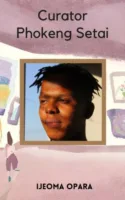Phokeng is a name to be reckoned with in the art world in South Africa. Hailing from Bloemfontein and at 31 years old, he is a curator in Cape Town and has worked at Zeitz MOCAA, the world-famous art museum in Cape Town. His work is multi-disciplinary, as he recently completed his PhD in Anthropology at the University of the Western Cape through the Centre of Humanities Research. His most recent collaboration was exhibited at the Johannesburg Art Fair titled ‘Exhibition Match’, which provided social commentary on how soccer, art and politics connect to each other.
So for those who don’t know what a curator is, can you explain what a curator does?
An art curator is a professional responsible for selecting, organising, and presenting artworks in galleries, museums, or exhibitions. They play a crucial role in shaping the narrative of an art collection, ensuring that art is displayed in a meaningful and engaging manner for the broader public to appreciate and understand.
What drew you to the work that you do now when you were younger?
My passion for people and a deep interest in the ways individuals express their ideas about themselves and the world around them are at the core of my enthusiasm for art and cultural matters. People and their ideas have always been central to my engagement with this field.
What would you say is the difference between an artist and a curator?
The difference between an artist and a curator can vary significantly or be quite subtle, depending on the individuals involved. In the traditional sense, an artist is a creator and visionary craftsman or craftswoman who brings ideas into existence. On the other hand, a curator is the individual who assists the artist in realizing their ideas. Curators achieve this by situating the artist’s work within a specific context, whether it be in material, discursive, socio-political, or aesthetic terms. Over the last three decades, these roles have become increasingly flexible, with artists adopting curatorial roles and curators delving more into artistic interpretation and the materialization of their practice.
How important is art in the South African landscape, when considering the issues that affect young South Africans (e.g. unemployment, inequality)?
Art plays a more crucial role in contemporary South African society than ever before. During apartheid, art and culture served as battlegrounds for the struggle for freedom. In the post-apartheid context, while some aspects have evolved, many fundamental issues remain unchanged. It is at this critical juncture that art can intervene effectively by shedding light on the contradictions within our society. Additionally, art and creative thinking have the power to expand our perspectives on the world. In a nation grappling with high unemployment and profound inequality, art’s ability to challenge conventional thinking and stimulate individual initiative could function as a potent remedy for the social issues that afflict our country and its youth.
What advice would you give to a young South African who lacks access to resources but wants to enter the art world?
To excel in their craft, accomplished artists exhibit a remarkable ability to harness their immediate surroundings and the materials readily available to them. This underscores the importance of starting with the resources at hand. In situations where individuals may not possess their ideal tools or materials, a fundamental principle emerges: the need to cultivate a profound appreciation for what is already within their reach.
In your most recent project, ‘Exhibition Match’, you wanted to make political commentary through a popular sport like soccer. How important is making the public engage with art in the work you do?
Public engagement plays a pivotal role in my work, primarily driven by my fervent desire to render art accessible to a wider audience. Much like how the presence of supporters enhances the experience of football, art similarly thrives when it connects with a diverse audience. The measure of its significance is amplified by its ability to resonate with individuals and effect transformative changes in their lives, regardless of the scale of the impact. Thus, the centrality of impact remains paramount in my professional endeavours.
Where can we find your work and follow you?
The majority of my work is readily accessible online. A simple Google search of my name will yield a comprehensive listing of my professional portfolio. Additionally, archives of past projects can be found on my Instagram profile, offering a visual record of my previous endeavours.
Tell us: what kind of art are you interested in, and why?


